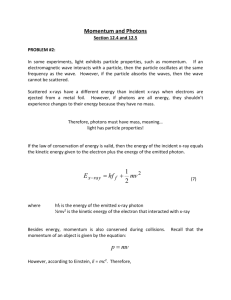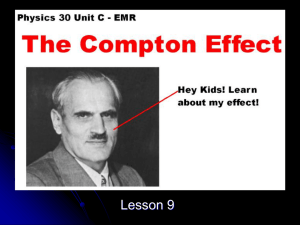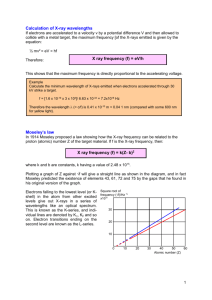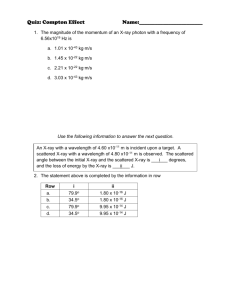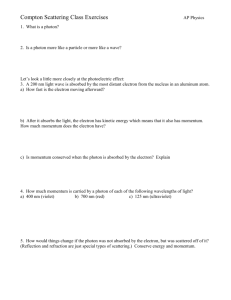Lesson 35: Compton Effect
advertisement
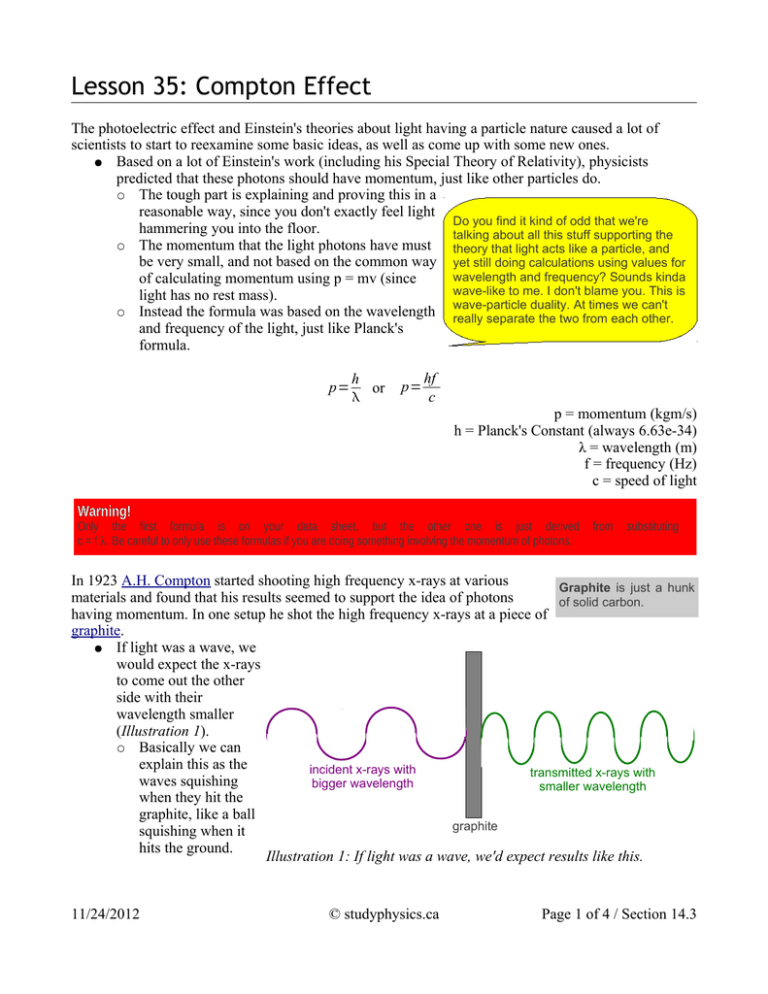
Lesson 35: Compton Effect The photoelectric effect and Einstein's theories about light having a particle nature caused a lot of scientists to start to reexamine some basic ideas, as well as come up with some new ones. ● Based on a lot of Einstein's work (including his Special Theory of Relativity), physicists predicted that these photons should have momentum, just like other particles do. ○ The tough part is explaining and proving this in a reasonable way, since you don't exactly feel light Do you find it kind of odd that we're hammering you into the floor. talking about all this stuff supporting the ○ The momentum that the light photons have must theory that light acts like a particle, and be very small, and not based on the common way yet still doing calculations using values for wavelength and frequency? Sounds kinda of calculating momentum using p = mv (since wave-like to me. I don't blame you. This is light has no rest mass). wave-particle duality. At times we can't ○ Instead the formula was based on the wavelength really separate the two from each other. and frequency of the light, just like Planck's formula. p= h or p= hf c p = momentum (kgm/s) h = Planck's Constant (always 6.63e-34) λ = wavelength (m) f = frequency (Hz) c = speed of light Warning! Only the first formula is on your data sheet, but the other one is just derived c = f λ. Be careful to only use these formulas if you are doing something involving the momentum of photons. from substituting In 1923 A.H. Compton started shooting high frequency x-rays at various Graphite is just a hunk materials and found that his results seemed to support the idea of photons of solid carbon. having momentum. In one setup he shot the high frequency x-rays at a piece of graphite. ● If light was a wave, we would expect the x-rays to come out the other side with their wavelength smaller (Illustration 1). ○ Basically we can explain this as the incident x-rays with transmitted x-rays with waves squishing bigger wavelength smaller wavelength when they hit the graphite, like a ball graphite squishing when it hits the ground. Illustration 1: If light was a wave, we'd expect results like this. 11/24/2012 © studyphysics.ca Page 1 of 4 / Section 14.3 ● Instead, Compton found that the x-rays scattered after hitting the target, changing the direction they were moving and actually getting a longer wavelength. ○ Remember, longer wavelength means smaller frequency. ○ Since E = hf, the scattered photons had less energy! Somehow, the x-ray photons were losing energy going through the graphite. So where'd the energy go? Compton found that electrons were being thrown off the target at an angle. ● Compton was able to explain all he was seeing (which became known as the Compton Effect) by using ○ The conservation of energy (the energy the photon lost had to go somewhere). ○ The photon theory of light (to figure out the momentum of the photons). ○ The conservation of momentum (to explain the angles things were shooting off at). scattered x-rays with longer wavelength incident x-rays with small wavelength graphite ejected electron Illustration 2: What Compton actually observed. If we looked at this in terms of momentum, we'd need to be careful about using the correct momentum equations for each part. ● Incident x-rays h The original x-rays have a small wavelength, and the formula p= shows us that this means it has a lot of momentum. ● Scattered x-rays The x-rays that made it through have a bigger wavelength, so momentum. ● p= h means it has less Ejected electrons We would calculate the electron's momentum using a classic p=mv calculation. 11/24/2012 © studyphysics.ca Page 2 of 4 / Section 14.3 Compton found that if he did all the calculations, including treating this as a 2-D momentum collision, the numbers worked beautifully. ● In fact, it's almost spooky just how perfectly the numbers worked out. It was basically a 100% perfect conservation of momentum. ● This showed that the particle model of light with all its talk about photons must be correct. ○ This was a turning point in the particle theory of light, when the majority of physicists started to really believe the wave-particle duality of light was probably correct. After looking at the data he got from his experiments, Compton also found that he could predict the exact change in the wavelength between the incident and scattered x-rays. ● His formula was based on the wave-particle duality of light, as well as the angle of the scattered x-ray. = h 1−cos mc Δλ = change in wavelength between incident and scattered (m) h = Planck's Constant m = mass of electron (kg) c = speed of light θ = scattered x-ray's angle Example 1: An x-ray light source with a wavelength of 1.28e-12m is shot at a piece of graphite. On the other side, the x-ray is observed to have scattered at an angle of 15o away from the original path. Determine the wavelength of the scattered x-ray (ignore sig digs). Then determine the velocity of the ejected electron. First, draw a sketch just to make sure you have everything correct. Rather than go to the trouble of drawing the x-rays as waves, we'll just draw them is vectors to show their paths. 15O λ = 1.28e-12m electron graphite First we'll figure out the scattered x-ray's wavelength... h Δ λ= (1−cos θ) λ scattered =Δ λ+ λincident mc λ scattered =8.26607287e-14+1.28e-12 m 6.63e-34 Δ λ= (1−cos15 o ) λ scattered =1.362660729e-12 m 9.11e-31 (3.00e8) Δ λ=8.266072876e-14 m 11/24/2012 © studyphysics.ca Page 3 of 4 / Section 14.3 We will handle the second part of the question like any other 2D conservation of momentum question, where we know stuff about two things and figure out the third. Let's figure out the momentum (without rounding for sig digs yet) of the two x-rays... Incident X-Ray Scattered X-Ray h h p= p= λ λ 6.63e-34 6.63e-34 p= p= 1.28e-12 1.362660729e-12 p=5.1796875e-22 kgm/ s p=4.86548108422e-22 kgm/ s The incident x-ray is all of the “before” momentum, and it's all along the x-axis. So the momentum before the collision is 5.18e-22 kgm/s. We need to break up the scattered x-ray into x-axis and y-axis components, and use them to figure out the electron's momentum. 22 7e4.8 y 15O x x-component y-component adj hyp adj=cos θ(hyp) adj=cos 15o (4.87e-22 ) adj=4.69969383657e-22 opp hyp opp=sin θ (hyp) opp=sin 15o ( 4.87e-22) opp=1.25927916818e-22 cos θ= sin θ= The electron has the rest of the x-axis momentum, and a y-axis momentum that cancels out the scattered x-ray... x-component 5.1796875e-22 – 4.69969383657-22 = 4.79993663428e-23 4.80e-23 θ 1.26e-22 y-component -1.25927916818e-22 Figure out the angle and the hypotenuse, and then use it to get the velocity. opp tan θ= adj 1.26e-22 tan θ= 4.80e-23 θ=69.13488379=69.1o p=mv p v= c 2=a2 + b2 m c 2=(1.26e-22)2 +(4.80e-23)2 1.35e-22 v= c=1.34765646229e-22 9.11e-31 v=147 931 554=1.48e8 m/s So the electron is moving at 1.48e8 m/s [69.1O below the path of the original x-ray]. Homework p723 #1,2 11/24/2012 © studyphysics.ca Page 4 of 4 / Section 14.3
